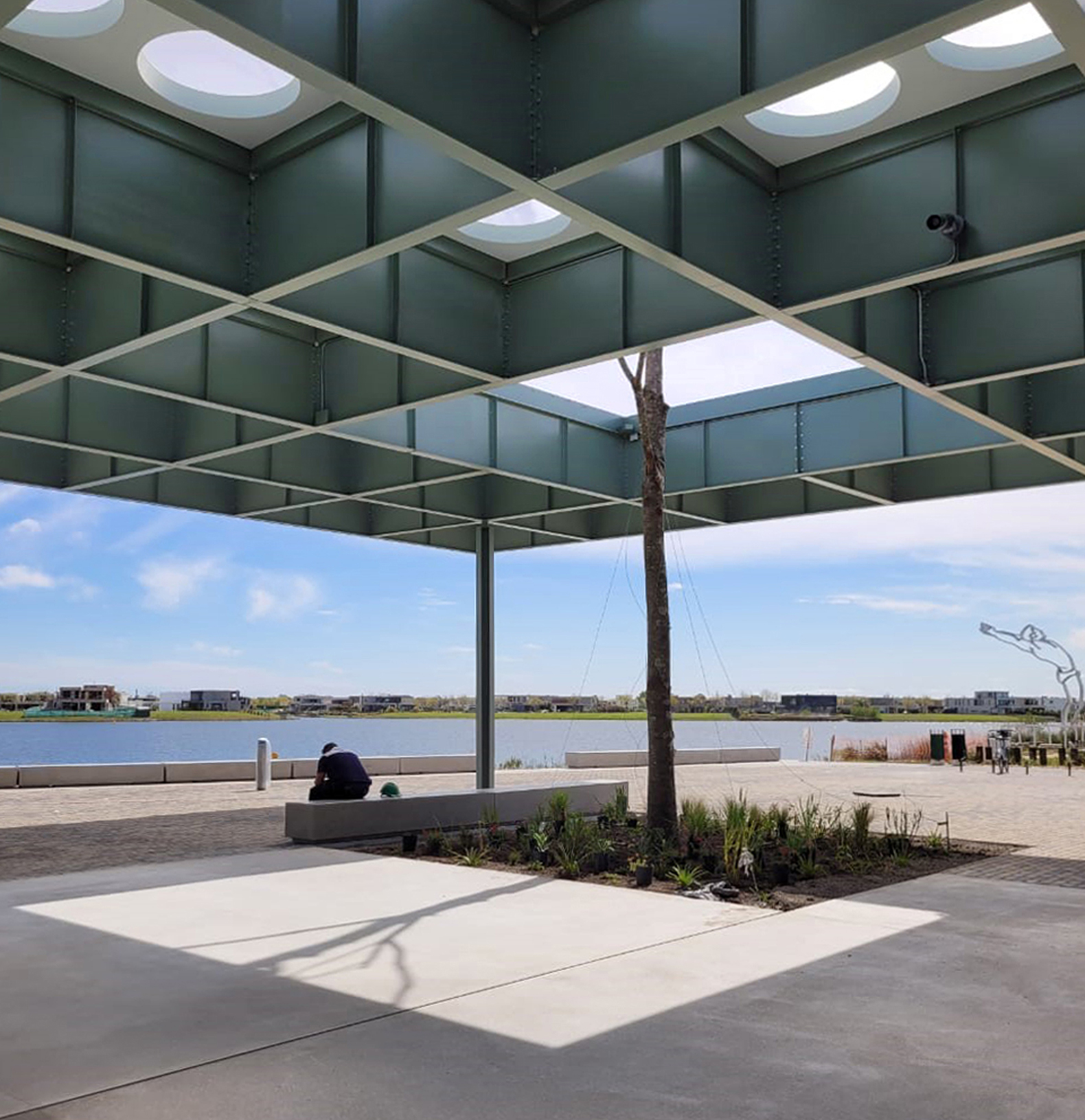
The museum complex developed by estudioHerreros houses three pavilions, where we find the different cultural spaces of the program. A porous roof crossed by natural light and vegetation connects the three pavilions through a space that blurs the categories of interior-exterior and natural-artificial due to its porous and transparent construction morphology, in a flexible space without limits or hierarchies.
The grid structure of full-web steel beams that form the roof is crowned by a set of translucent domes that shed their enigmatic light on three plazas: one open to the city, another to the lake and another to the alder forest, which are intended to be flexible and programmable exhibition spaces.

MALBA PUERTOS by estudioHerreros. Photograph by Juan Giménez.
Project description by estudioHerreros
“The project of estudioHerreros emerged from the desire to expand the museum's cultural and social impact to audiences not typically engaged with contemporary art, as well as the need to accommodate new forms of expression and exhibition in line with the demands of a 21st-century museum. Today, disciplines and formats are increasingly hybrid and interdisciplinary, and the visitor plays an active role in the artistic experience.”
Eduardo Costantini, Founder of MALBA Museum.
MALBA PUERTOS, the new enclave of the Buenos Aires institution located in Escobar, is not just a museum but a series of architectural and landscape interventions designed to establish a cultural and artistic hub for the northern region of Buenos Aires Province. At MALBA PUERTOS, three essential interests converge to understand the current role of cultural institutions: art as a tool to question today’s contradictions; the fragility of nature as a central force shaping our relationship with the world; and a commitment to local communities, whose histories deserve to be reimagined. In response to this vision, estudioHerreros' architecture, developed along with Bulla for landscaping, FloraEstudio for the industrial production of furniture and equipment, and local architect Torrado Arquitectos, deliberately avoids a compact building with clearly defined boundaries. Instead, it features a porous, transparent construction with no distinct perimeter or hierarchies, seamlessly blending the enjoyment of the most experimental creative practices, the meeting of disconnected social groups, and transgenerational learning, thanks to the flexible spatial and structural approach that blurs the conventional categories like interior and exterior or natural and artificial.

MALBA PUERTOS represents the convergence of three exhibition models that extend beyond the conventional museum experience, rarely encountered together: an open-air sculpture circuit designed to connect the surrounding urban landscape with contemporary art while highlighting the invaluable natural reserve of the lakes; a geometric forest framing a grove of alder trees, with clearings that serve as open-air exhibition spaces; and a composition of three pavilions and three outdoor plazas, forming the project's core.
A large roof of 3,500 sqm, pierced by three enormous Ibirá Pitá trees, rests on three pavilions that contain an exhibition space with a small bookstore and design shop; a visitable art storage area with an educational space and a café; and a fully glazed volume housing a permanent sculptural installation by the Tucumán artist Gabriel Chaile. The lightweight, prism-like pavilions are framed by a repetitive steel perimeter structure with opaque reconstituted cement panels. Their simplicity, industrial character, and natural integration of exposed installations diffuse the typical solemnity often associated with museum entry and navigation.

The large roof is composed of a grid of solid-web steel beams, crowned by a sea of translucent domes that cast an enigmatic light onto three plazas: one facing the city, one toward the lake, and another toward the alder forest. These outdoor spaces are conceived for exhibitions, gatherings, and diverse programming, accommodating everything from markets to performances, cinema screenings, exhibitions, and celebrations. The architecture provides the space and infrastructure that make this multiformat experience possible, extending into the natural corridor of the "Forest Rooms," which contain three outdoor exhibition spaces surrounded by alder trees. The geographical sequence along the lake-museum-forest axis is enriched by the integration of greenery, water, wind, and sunlight as energy resources, using vegetative beds for humidity control, rainwater reuse tanks, photovoltaic solar panels, and air currents channeled through vegetative screens.
The ritual of "visiting" a museum transforms into "inhabiting" the fluidity of open and enclosed spaces. The primary focus is on children and teenagers, for whom the architecture makes the typically hidden and mysterious art storage visible and accessible. This fosters an understanding of the significance of an art collection as a living chronicle of their own history. Additionally, there is a dedicated space for educational activities, such as art classes, workshops, screenings, conferences, and more, complementing the dynamic use of the areas beneath the expansive roof.
MALBA PUERTOS is a manifesto for the institutions we aspire to, demonstrating how the transformative power of architecture can expand and liberate artistic practices beyond the boundaries of orthodoxy.

































